Judith Content: The infinite possibilities of Shibori
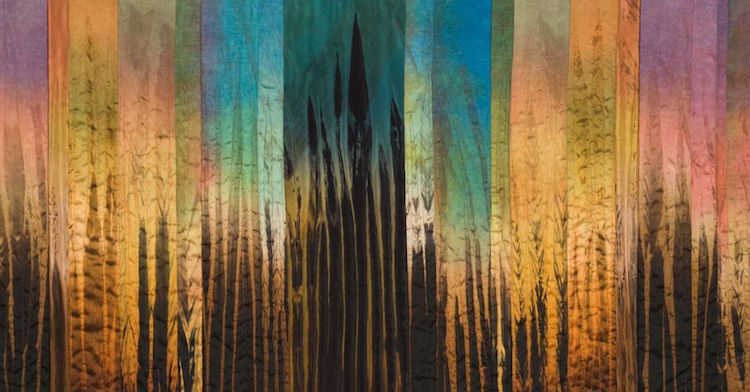
Judith Content has been a full-time studio artist since 1979. Her work explores the essence of an image, memory, or moment in time.
She finds inspiration in nature’s landscapes, from coastal marshes to desert canyons and hopes the meditative quality of her work encourages viewers to draw upon their own memories and experiences.
Judith has work in several museum collections including The Museum of Art and Design, New York, The Fine Arts Museums of San Francisco and The Museum of Quilts and Textiles in San Jose as well as several pieces in the state of New Mexico’s Public Art Collection, The city of Nagoya’s shibori collection and numerous private collections across the US.
In this interview, Judith explains how her imagination was captured by shibori and the influence this ancient technique has had on her work. We learn what materials she enjoys experimenting with and how she can’t live without her magical magnetic wand!
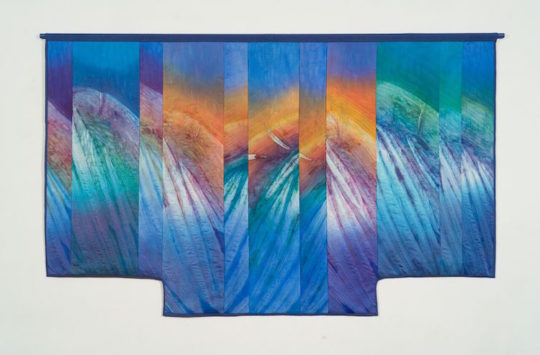
Judith Content, Torrent, 2011, 44″ x 69″
The rich diversity of textile traditions
TextileArtist.org: What initially attracted you to textiles as a medium?
Judith Content: My parents were avid collectors of early American and European antiques. Their focus was glass and furniture but I was entranced by the textiles they occasionally acquired, especially paisley shawls, Navajo rugs and domestic stitcheries.
I also had an uncle who travelled the world as a merchant marine in the early 1900s. He brought back many treasures and gave me my first Japanese kimono when I was only a teen. It hangs on my wall to this day.
When I moved to the West Coast from New England in 1975, for my senior year in high school, I soon came to appreciate the rich diversity of textile traditions to be found here. I was attracted to ancient and historical textiles from the Americas, Asia, Africa and Europe.
I was especially drawn to costume, embellishment, dyeing, weaving, embroidery and functional fibre such as woven vessels. I was attracted to the imaginative use of indigenous and traded materials, and the wonderful colours, textures and artistic designs these many cultures could achieve.
I studied art in college and continually broadened my knowledge of textiles through study, research, travel and hands-on experimentation.
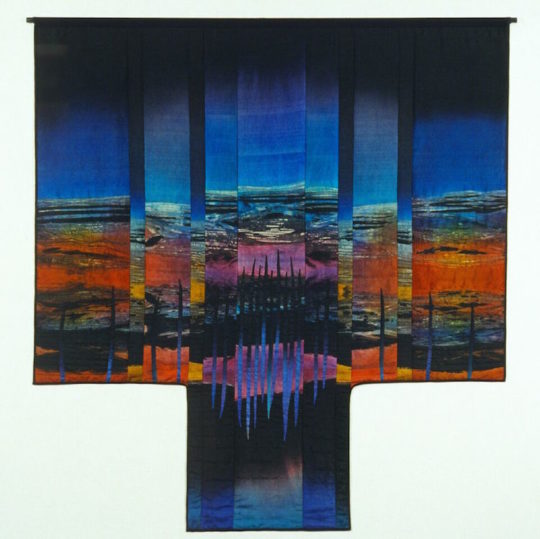
Judith Content, Precipice, 2005, 70″ x 60″
And, more specifically, how was your imagination captured by shibori?
I think my imagination was really captured by shibori. The infinite possibilities of this ancient Japanese dye technique always amazed me. The San Francisco Bay Area of the 70’s and 80’s was a mecca for fibre artists. I feel so fortunate to have witnessed it.
Besides studying textiles as part of a Bachelor of Fine Arts, at San Francisco State University, I was able to take workshops on dyeing and surface design throughout the Bay Area. I studied at Fiberworks, Straw into Gold and Pacific Basin in Berkeley, De Anza College in Cupertino and the Palo Alto Cultural Centre in Palo Alto, to name a few.
However, in terms of shibori, I am largely self-taught. I first learned about arashi-shibori from Ana Lisa Hedstrom in 1978, when she gave a one-hour demonstration during a college surface design class. I was mesmerized and went home to experiment.
At first, I used tiny bits of silk, pleated and secured to broom handles. Wanting to work larger I found glass bottles a handy tool to use. To this day I dye relatively small pieces of silk and assemble them by stitch to create larger works. Call it piecing or call it collage I find combining multiple parts yields a rich and nuanced surface.
I continue to experiment and explore shibori’s possibilities. I am currently exploring Itajime shibori in conjunction with arashi-shibori. I am using distressed magnolia and bamboo leaves as resists, along with a variety of threads, cords and ribbons. Combined with complex fold techniques I’m excited by the results and eager to do more.
What or who were your early influences and how has your upbringing influenced your work?
I was driven to work with my hands from an early age. I painted at my mother’s side as a child, and when I grew older I created my own creative spaces in garages, basements, sheds and porches. My father taught me to crochet and trained me in woodworking and I loved working with all kinds of media.
Because we lived in rural areas, getting a job as a teen was difficult. I enjoyed making pottery so I saved up and bought myself a potter’s wheel, kiln, clay and glazes and gave pottery classes for both children and adults. This was my first taste of being self-employed and I liked it.
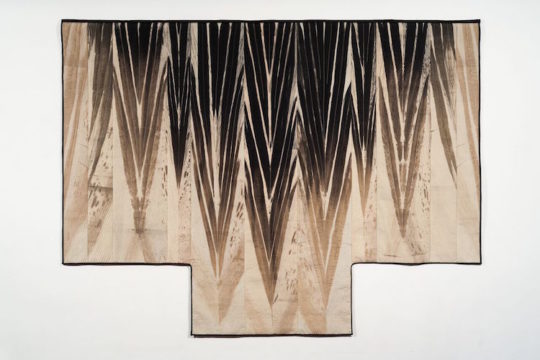
Judith Content, Syncline, 2015, 58″ x 78″
Textiles had everything I was looking for
What was your route to becoming an artist?
I studied watercolour painting from an early age and was encouraged to do so by a family of artists and engineers. I always hoped to be an artist and assumed, if that came to pass, I would be a painter. Moving to California in 1975 changed all that. Suddenly I was exposed to all kinds of new cultural and artistic influences and while at San Francisco State University, I basically took every class the art department had to offer.
Then as a lark, I took a class in textiles. I had always loved textiles, but I never considered them a medium for fine art. After studying textiles intensely for about a year and a half I had completely changed my mind about that. For me, textiles had everything I was looking for. I could explore surface design, colour, pattern and design. I could work with texture, relief and dimension. I could also create components and build with them to create work both intimate or architectural in scale.
I feel that my background in watercolours and my love of building things led naturally to the construction of quilts. Every aspect of my work, from the dying to the piecing, to the quilting relies on intuition as well as experience.
Through my work, I hope to communicate with the viewer on an emotional as well intellectual level. I liken my work to the Japanese haiku, in that they explore the essence of an image, memory, or moment in time. Just as haiku have different interpretations, I hope the meditative quality of my work encourages viewers to draw upon their own memories and experiences when contemplating my work.
I’m drawn to intuitive symmetry, where images that seem symmetrical are not, after all, exactly the same. I use the kimono form because its balance and harmony lend itself to this approach so beautifully. Using shibori and the abstract kimono canvas to work on, I aspire to:
Create subtle visual tension by intersecting dynamic and harmonious elements through colour, pattern and texture.
Dr. Sandra Sider, ‘Intuitive Symmetry: Works on Silk by Judith Content’. Monograph, Texas Quilt Museum, 2015
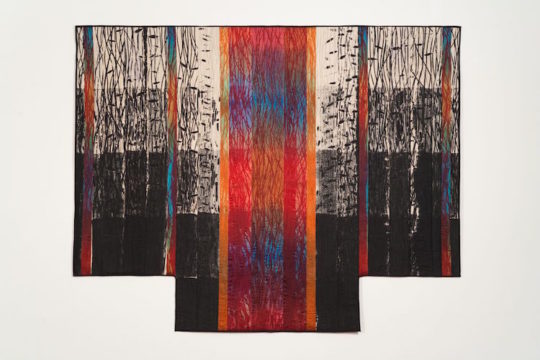
Judith Content, Labyrinth, 2015, 64″ x 81″
How would you describe your work and where do you think it fits within the sphere of contemporary art?
In answer to this question I would again like to quote Dr. Sandra Sider:
Judith Content’s quilts fall…in the category of Process Art….first practiced by sculptors in the mid 1960s. Robert Morris, the chief theorist of this movement…believed that the art “process” should lead to its ultimate form, rather than having a pre-conceived form dictate the process used to create it. While Content definitely works within a specific format, often the T-shaped quilt, she lets the hues and patterns of her shibori speak to her as she assembles each quilt. Her dyed fabrics evoke subtleties of mood, landscape, natural phenomena, etc. Attuned to both nature and human nature, her abstract, painterly quilts resonate with meaning.
Do you use a sketchbook? If not, what preparatory work do you do?
I compile notebooks filled with images that inspire me. I make them with found papers such as brochures and postcards as well as my own drawings, sketches and paintings. I use them to refer to for inspiration. I also take many photographs with my iPhone. I edit these and store them digitally for ideas and inspiration.
I also find shibori dyeing its own source of inspiration. I love to do purely experimental dyeing, just to see what happens. If something interesting takes place I run with it. This experimentation is often incorporated into new work.
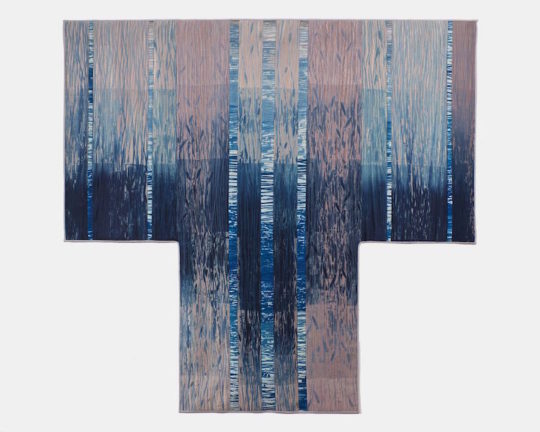
Judith Content, Indigo Ice, 2016, 74″ x 70″
Tell us about your process from conception to conclusion.
My work involves a series of several different processes. The first is the dyeing of the silk that will become the face of my artwork. I have explored shibori dyeing since encountering it while studying art at San Francisco State University in the late 1970s. It resonated with me immediately and has excited me for decades. I don’t keep journals of my dye explorations. I prefer to work intuitively and spontaneously. I let each dye session inform the next mingling experience with experimentation.
First, I meticulously pleat panels of silk into origami-like bundles. I use white silk if I anticipate dyeing it, or pre-dyed silk if I plan to discharge (remove) colour. The bundles are secured to ABS plastic pipe with a combination of thread, yarn, ribbon or cording. Both the pleats and the filaments resist the dye or the discharge from penetrating the silk. In this way, I can add or subtract colour creating virtually unlimited patterns on the silk. I often over-dye to soften the original patterns, or dip-discharge to diffuse and abstract the design.
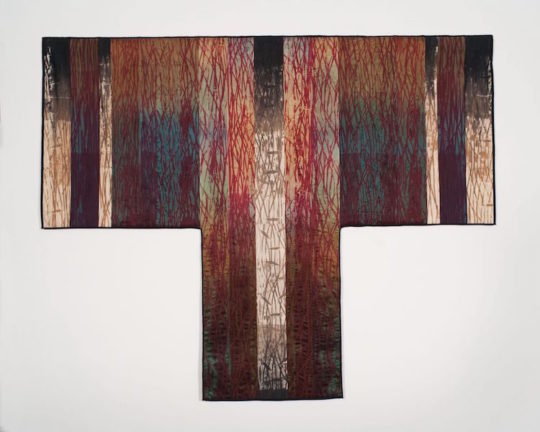
Judith Content, Bittersweet, 2015, 58″ x 73″
I often do a week or more of dyeing in order to create a rich collection of silks. I want a variety of silks that are unique but work well together. In this way I create my palette much the same way a painter mixes her paints. I use Japanese acid dyes called Miyako-zome and I only use the dye primary colours: turquoise, magenta, and yellow. I layer the colours by dipping or pouring them over the surface of the pole. It can take minutes or hours to gradually achieve the intensity I am looking for. Over-dying and discharging add other levels of complexity.
When I think I have enough silk to work with I start the piecing process. Similar to collage, I work directly on the design wall, looking for exciting combinations of colour, line and pattern. The silks are steadily arranged, rearranged, cut, torn and refined until the composition feels right.
After the composition is complete I quilt it. I use machine quilting to define and accentuate patterns in the silk. I also use quilting to create a subtle texture. Sometimes I use quilting to diffuse or soften patterns in the silk. I think of quilting as drawing and use it more and more as the year’s pass. My early work was sparingly quilted and my new work is densely stitched. It’s interesting to see how things change.
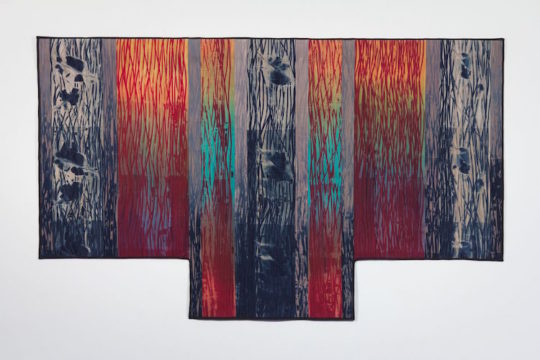
Judith Content, Mariposa, 2016, 40″ x 66″
A quiet, peaceful space
What environment do you like to work in?
My studio is in an addition just steps away from the rest of the house. It’s a quiet, peaceful space with whitewashed walls, large windows, and doors to the garden. I try and keep it organised and tidy. I don’t work well in chaos.
I covered one entire wall with white denim, and use this space as my design wall. I pin dyed silks to the wall to audition combinations while looking for juxtapositions that resonate. In this way, I create my compositions. I also sew and quilt in the studio.
My sewing machine was inherited from my grandmother and is a sturdy vintage Singer. It does everything I ask of it and more. Next to where I sew is a wall of thread, loosely arranged by colour, displayed in old typeset drawers. From here I look out at the front garden of black bamboo, ceramic sculptures and water basins.
Because I live in a mild climate here in Northern California, I’m able to do all my shibori dyeing and discharging in the backyard, year-round, rain or shine. I heat water at the kitchen stove and carry stainless steel dye pots outside to simmer on electric hot plates. I work under large canvas market umbrellas. I love the light as well as the fresh air of working outside.
What currently inspires you?
I am inspired by the natural landscape and how it translates to cloth. I’m inspired by the play of light over water and fascinated by the way imagery is abstracted as it becomes obscured by fog. I’m interested in mirrored images, reflections, mirages, things that are not quite what they seem at first. I’m always looking for interesting patterns and textures on natural surfaces such as rocks, tree bark, sand and clouds.
I’m drawn to horizontal lines such as water meeting the horizon and geologic layers of rock and stone. I’m also fascinated by vertical lines such as those found in reeds, grasses, tule and trees. In my work, I love to visually weave these lines together through the use of piecing, quilting and occasionally applique.
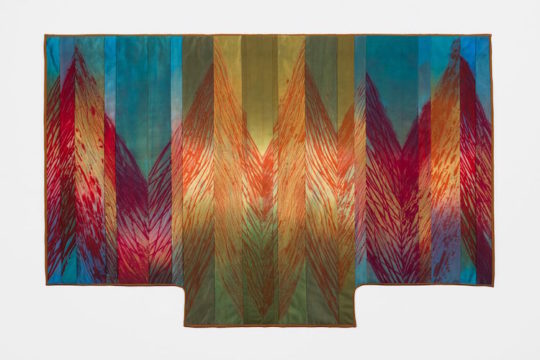
Judith Content, Spires, 2017, 41″ x 63″
How has your work developed since you began and how do you see it evolving in the future?
My earliest work, just out of college, was wearable art. I used the Turkish coat and the kimono as the canvas, and shibori dyed silks as the surface design. After a few years exploring the world of fashion I realised I wanted to work bigger. I craved making work on an architectural scale.
I found gallery representation that allowed me to follow this dream and in the 1980s and 90s, I designed and created many site-specific commissions for corporate, health and residential spaces that reached up to two stories in height.
Then at some point in the late 90s, I realised I wanted to work smaller. I still wanted to make work for the wall, but I wanted it to be on a more human scale. This led to work often recalling the clothing shapes of my earliest explorations, such as the kimono and ruana, but not intended to wear.
This is where I am today, still avidly exploring an ever-expanding network of shibori dye techniques. I am also playing with sculptural forms such as round, rock-like assemblages I call ‘Skimming Stones’. In between wall piece, I work with a variety of other medias, such as artist’s books, collage and jewellery design, just to name a few.
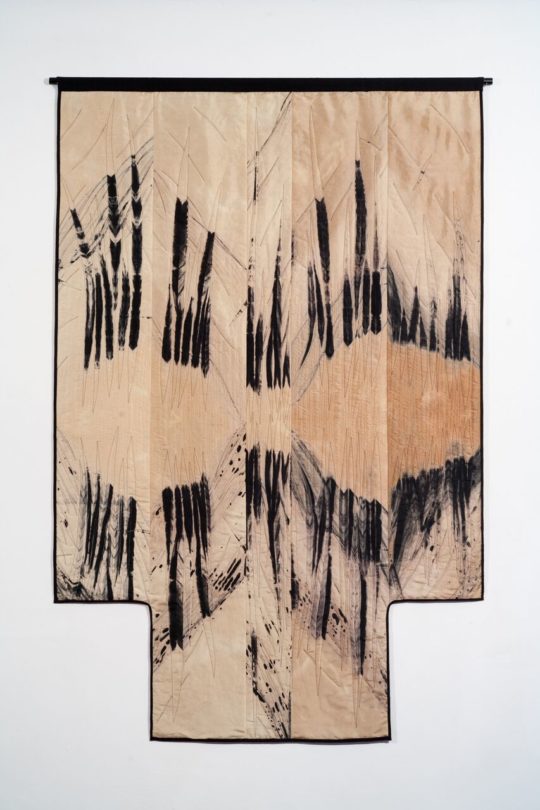
Judith Content, Migration, 2011, 55″ x 69″
What advice would you give to an aspiring textile artist?
Find your voice and listen to it.
Can you recommend 3 or 4 books for textile artists?
Two books by Mary Schoeser come to mind, one titled Silk and the other titled Textiles. It’s essentially an encyclopedia of textiles with gorgeous photographs.
I would also recommend Memory On Cloth: Shibori Now, by Yoshiko I Wada, and Kimono Inspiration by Rebecca A.T. Stevens and Yoshiko I Wada.
What other resources do you use? Blogs, websites, magazines etc.
SAQA.com
Surface Design Journal
Fiber Art Now
SAQA Journal/Art Quilt Collector
What piece of equipment or tool could you not live without?
My Singer Sewing Machinecirca 1960
A magnetic wand that picks up pins like magic.
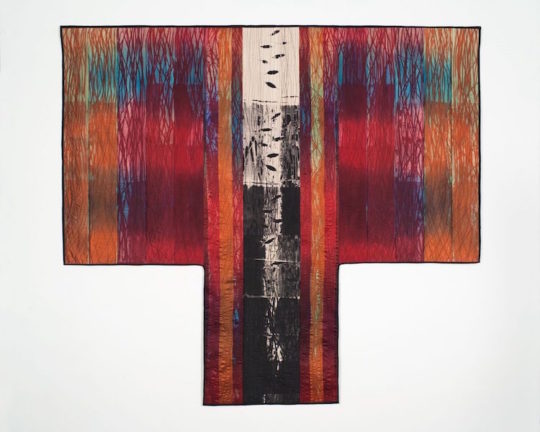
Judith Content, Aftermath, 2015
Do you give talks or run workshops or classes? If so where can readers find information about these?
I do lecture but I rarely teach. It’s best to make enquiries via email at judithcontent@earthlink.net or through my website.
How do you go about choosing where to show your work?
I submit work to juried exhibitions when those exhibitions have an excellent reputation, reputable jurors, a professional facility and ideally produce a catalogue. I use this criterion when deciding to accept an invitational exhibition as well.
I’m most likely to accept an invitation if it comes from a trusted peer, a well-regarded curator, a person I hold in esteem or in friendship or it takes place in a museum or major art facility.
Where can readers see your work this year?
I have work travelling in the Studio Art Quilt Associates (SAQA) exhibition titled H2Oh!.
Go to SAQA.com for the schedule.
My work is represented by Tansey Contemporary Gallery, 652 Canyon Road, Santa Fe, NM 87501 505-995-8513 and their new flagship location 1743 Wazee Street, Denver, CO 80202 720-596-4243.
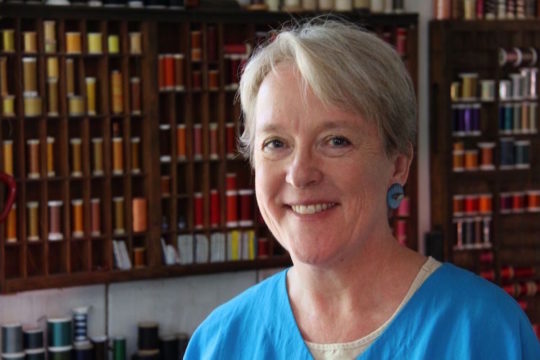
Judith Content, Frontpiece, Portrait, 2015
For more information visit: www.judithcontent.com
Got something to say about the techniques, materials and processes used by this artist – let us know by leaving a comment below.
















Hi guys,
Loved this article very inspiring not heard of this artist before coming from down under. Beautiful compositions must be magic to see in reality.
What an interesting lady. And what beautiful pieces that are truly works of art. I am definitely going to have another go at shabori because my only introduction (in the UK) was with traditional indigo dye that produced a 3″ piece of stripy fabric. Judith produces luscious colours and uses the stips in original ways. Wonderfully original. Thank you Judith for sharing your work and practise with us.
Beautiful!
Amazing!! I have admires her work for years!!
very inspiring…i invite you to discover my work and my website http://inesart.net/